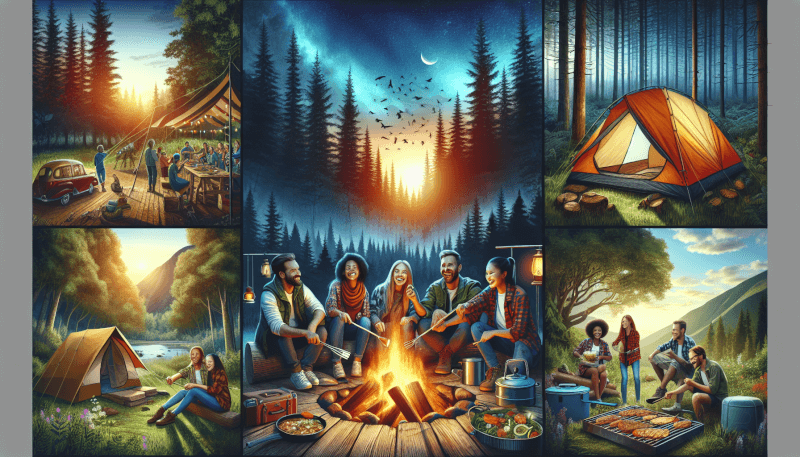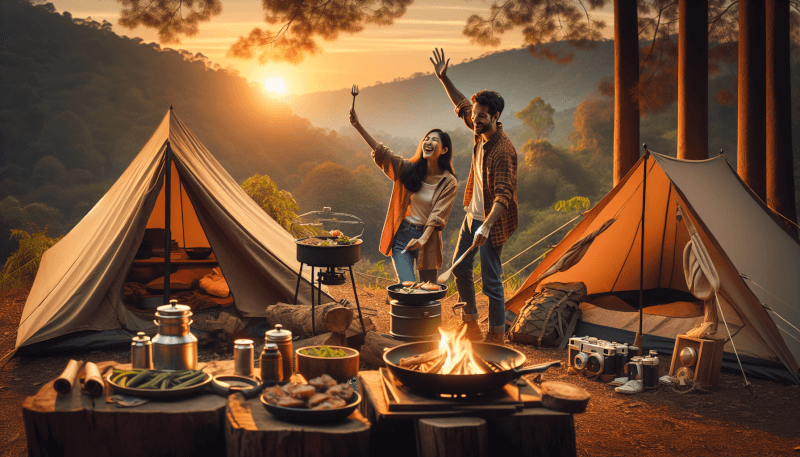So you’ve decided to embark on a camping adventure, but you’re not quite sure where to begin? Look no further! This article offers a concise yet comprehensive guide to the best camping techniques that will ensure a successful and enjoyable outdoor experience. Whether you’re a seasoned camper or a novice venturing into the wilderness for the first time, these tried-and-tested tips and tricks will equip you with the knowledge and skills necessary to make your camping trip an unforgettable one. From setting up a campsite to cooking over an open fire, you’ll discover all the essential strategies and insights to enhance your camping adventure. So pack your gear, grab your sense of adventure, and get ready to explore the great outdoors with confidence and excitement!

Choosing the Right Campsite
Choosing the right campsite is crucial for a successful camping adventure. Here are some factors to consider when selecting your camping spot.
Consider the location
The location of your campsite can greatly impact your overall camping experience. Consider the proximity to attractions or activities you plan to do during your trip. Additionally, think about the accessibility of the location and the travel time required to reach it. If you prefer a more secluded and peaceful camping experience, look for campsites that are away from popular tourist areas.
Check the facilities available
Before settling on a campsite, it’s important to check the facilities available. Are there clean bathrooms and showers nearby? Is there a water source for cooking and drinking? Are there picnic tables or fire pits provided? Having these amenities available can greatly enhance your camping experience and make your stay more comfortable.
Look for a flat and well-drained area
When selecting a campsite, opt for a flat and well-drained area. A flat surface ensures that your tent will be stable and secure. Avoid areas with sharp rocks or branches that could damage your tent. Additionally, choose a spot that is well-drained to prevent water pooling inside your tent during rainstorms. This will help keep you dry and comfortable throughout your camping trip.
Avoid areas prone to flooding or strong winds
It’s important to avoid areas that are prone to flooding or strong winds. Camping in flood-prone areas can be dangerous, as rising water levels can put you at risk. Similarly, camping in areas with strong winds can make your camping experience uncomfortable and potentially unsafe. Take the time to research the weather patterns of the area before choosing your campsite to ensure a safe and enjoyable camping adventure.
Setting Up Your Tent
Setting up your tent properly is essential for a comfortable and hassle-free camping experience. Follow these steps to ensure a successful tent setup.
Choose a suitable spot
The first step in setting up your tent is to choose a suitable spot. Look for a level surface that is clear of rocks, sticks, and other debris. Ensure that there are no obstacles such as tree roots or ant hills that could affect your tent’s stability. Additionally, consider the direction of the wind and the position of the sun when selecting your spot.
Clear the area of debris
Before setting up your tent, take the time to clear the area of any debris. Remove any rocks, branches, or other objects that could puncture or damage the tent floor. This will provide a clean and comfortable surface for your tent and help prevent any unwanted surprises during your camping trip.
Lay down a groundsheet or tarp
To further protect your tent from moisture and provide extra insulation, lay down a groundsheet or tarp before pitching your tent. This will act as a barrier between the tent floor and the ground, preventing water seepage and adding an additional layer of cushioning. Make sure the groundsheet or tarp is slightly smaller than the footprint of your tent to avoid pooling water.
Assemble the tent according to instructions
Once the area is clear and a groundsheet or tarp is in place, it’s time to assemble your tent. Carefully follow the instructions provided by the manufacturer to ensure that all pieces are correctly connected. Take your time to properly secure the poles and attach the rainfly if necessary. A properly assembled tent will provide the necessary shelter and protection for a comfortable night’s sleep.
Secure the guy lines and stakes properly
To ensure that your tent stays in place during windy conditions, it’s important to securely fasten the guy lines and stakes. Attach the guy lines to the appropriate loops on your tent and stake them into the ground at a 45-degree angle. Make sure the stakes are firmly in the ground and the guy lines are taut. This will help prevent your tent from collapsing or blowing away in strong winds.
Consider using a tent footprint
Using a tent footprint can provide additional protection for your tent. A tent footprint is a tarp-like sheet that goes underneath your tent and provides an extra layer of insulation and water resistance. It can help prolong the lifespan of your tent by preventing wear and tear on the tent floor. Consider investing in a tent footprint for added durability and comfort during your camping trip.

Building a Campfire
No camping trip is complete without a cozy campfire. Follow these steps to safely build and enjoy a campfire during your outdoor adventure.
Find a suitable fire pit
When building a campfire, it’s important to find a suitable fire pit. Look for designated fire pits or fire rings in your campsite. These are typically safe and approved areas for building fires. If there are no designated fire pits, choose a spot that is clear of vegetation and at least 15 feet away from any structures or flammable materials.
Gather dry and seasoned firewood
To ensure a successful campfire, gather dry and seasoned firewood. Look for fallen branches or dead wood that is dry and brittle. Avoid using live or green wood, as it tends to produce more smoke and does not burn as well. Additionally, check if firewood collection is allowed in the area or if you need to bring your own. Remember to always follow any firewood regulations to protect the local environment.
Create a fire ring
Before lighting your campfire, create a fire ring. Use rocks or stones to create a circle around your fire pit. This will help contain the fire and prevent it from spreading. It also provides a clear boundary for everyone to safely gather around the fire. Make sure the fire ring is wide enough to allow for proper ventilation and keep a safe distance from the fire.
Build the fire gradually
Building a campfire is a gradual process. Start by placing small twigs or dry leaves at the bottom of the fire pit. These act as tinder and help ignite the larger pieces of wood. Gradually add larger sticks and logs to build the fire. Remember to leave enough space between the wood to allow proper airflow. As the fire grows, add more wood as needed to maintain a steady and warm flame.
Never leave the fire unattended
When enjoying a campfire, it’s important to never leave it unattended. Always have someone in charge of the fire and ensure that there is constant supervision. Even a small flame can quickly turn into a dangerous fire if left unattended. Assign someone to be responsible for extinguishing the fire and make sure they are aware of the necessary safety precautions.
Ensure the fire is completely extinguished
Before leaving your campsite or going to bed, it’s crucial to ensure that the fire is completely extinguished. Use water or sand to douse the flames and stir the ashes to ensure everything is cool to the touch. Never leave a fire smoldering or hot, as it can easily reignite and cause a wildfire. Remember, it’s better to err on the side of caution and make sure the fire is completely out.
Cooking in the Wilderness
One of the great joys of camping is cooking delicious meals in the great outdoors. Follow these tips to make sure your cooking experience is safe, enjoyable, and satisfying.
Plan and prepare meals in advance
Before heading out on your camping trip, take the time to plan and prepare your meals in advance. Make a list of the ingredients you will need and pack them accordingly. Consider the length of your trip and the storage capacity of your cooler or food containers. Preparing meals in advance will save you time at the campsite and ensure that you have all the necessary ingredients on hand.
Use portable cooking equipment
When cooking in the wilderness, portable cooking equipment is essential. Invest in a reliable camping stove or grill that is lightweight and easy to transport. These portable cooking options are designed for outdoor use and provide a controlled and safe cooking environment. They are also more convenient than building a campfire for cooking, especially in areas where fire restrictions may be in place.
Pack essential cooking utensils
In addition to your cooking equipment, don’t forget to pack essential cooking utensils. Bring a set of durable and heat-resistant pots, pans, and utensils to cook your meals. Remember to also pack a knife, cutting board, and can opener. These utensils will make food preparation and cooking much easier and more efficient. Pack them in a sturdy and organized manner to prevent any damage during transportation.
Follow proper food safety guidelines
Food safety is crucial when cooking in the wilderness. Always keep perishable food items stored properly in a cooler with enough ice to maintain a safe temperature. Separate raw food from cooked food to prevent cross-contamination. Cook food thoroughly and ensure that it reaches the appropriate internal temperature. Keep surfaces and utensils clean and sanitize them regularly. Following these guidelines will help prevent foodborne illnesses and ensure a safe camping experience.
Dispose of waste properly
Proper waste disposal is essential when cooking in the wilderness. Dispose of food scraps, packaging, and other waste in designated trash bins or bear-resistant containers if available. If there are no trash bins, pack your waste in sealed bags and take it with you when you leave. Avoid leaving food scraps or trash at your campsite, as it can attract wildlife and potentially disrupt the local ecosystem. Take responsibility for your waste and leave the wilderness as pristine as you found it.

Preparing for Outdoor Activities
Planning ahead and being well-prepared for outdoor activities can greatly enhance your camping experience. Here are some tips to help you prepare for a variety of activities.
Research the area’s outdoor activities
Before embarking on your camping trip, research the area’s outdoor activities. Look for hiking trails, biking routes, fishing spots, or any other activities that interest you. Note the level of difficulty, the distance, and any necessary permits or equipment required. This will help you plan your days and ensure that you have the appropriate gear and skills for each activity.
Pack appropriate gear and equipment
Based on your research, pack appropriate gear and equipment for your chosen outdoor activities. If you plan to go hiking, pack sturdy and comfortable hiking shoes, a backpack, and a map or GPS device. If fishing is on your itinerary, bring your fishing gear and any necessary licenses. Having the right gear will allow you to fully enjoy and participate in each activity.
Wear suitable clothing and footwear
Wearing suitable clothing and footwear is key to staying comfortable and protected during outdoor activities. Dress in layers to accommodate changing weather conditions, and choose moisture-wicking fabrics to keep you dry. Always wear sturdy and comfortable footwear that is appropriate for the terrain. Protect yourself from the sun by wearing a hat and applying sunscreen regularly. Being properly dressed will ensure that you can enjoy outdoor activities to the fullest.
Stay hydrated and bring snacks
Outdoor activities can be physically demanding, so it’s important to stay hydrated and bring snacks to keep your energy levels up. Carry a reusable water bottle and drink plenty of water throughout the day. Hydration packs are also a convenient option for activities such as hiking or biking. Pack lightweight and nutritious snacks like trail mix, energy bars, or fresh fruit. Staying properly fueled and hydrated will help you have a more enjoyable and successful camping adventure.
Learn basic navigation skills
Before venturing into the wilderness, it’s essential to learn basic navigation skills. Familiarize yourself with reading a map and using a compass. Understand how to interpret trail markers or signs and identify landmarks. Knowing these basic navigation skills will help you navigate through unfamiliar terrain and ensure that you don’t get lost. Consider taking a navigation course or practicing these skills in advance to boost your confidence in the outdoors.
Safety and First Aid
Keeping safety a priority and being prepared with first aid knowledge can make all the difference in an emergency situation. Follow these guidelines to ensure your safety during your camping adventure.
Inform someone about your camping plans
Before heading out on your camping trip, inform someone you trust about your plans. Share details such as the location of your campsite, the duration of your stay, and any planned activities. This way, if anything unexpected happens or you fail to return on time, someone will know to check on your well-being. It’s always better to have someone aware of your plans for an added layer of safety and peace of mind.
Bring a well-stocked first aid kit
A well-stocked first aid kit is an essential item for any camping trip. Make sure your kit includes bandages, antiseptic wipes, adhesive tape, gauze pads, tweezers, scissors, and any necessary medications. Familiarize yourself with the contents of your first aid kit and how to use them appropriately. Having a well-equipped first aid kit will allow you to handle minor injuries and provide necessary care until medical help is available.
Learn basic first aid techniques
In addition to having a first aid kit, it’s important to learn basic first aid techniques. Take a first aid course or educate yourself on common injuries such as cuts, burns, sprains, and insect bites. Know how to properly clean and dress wounds, how to perform CPR, and how to treat common ailments like dehydration or heat exhaustion. Having these skills will help you respond effectively to emergencies and provide assistance to others if needed.
Be aware of local wildlife and potential hazards
When camping in the wilderness, it’s important to be aware of local wildlife and potential hazards. Research the area to understand what wildlife species you may encounter and how to safely coexist with them. Learn how to store food and dispose of waste properly to avoid attracting animals. Familiarize yourself with any poisonous plants or insects in the area and know how to identify them. By being aware and prepared, you can minimize potential risks and ensure a safe camping experience.
Follow safety guidelines for water activities
If your camping trip includes water activities such as swimming or boating, it’s crucial to follow safety guidelines. Always wear a properly fitted life jacket when boating or participating in water sports. Watch for signs of strong currents or dangerous underwater obstacles before entering the water. Avoid swimming alone, especially in unfamiliar areas. Be cautious of changing weather conditions and seek shelter in case of thunderstorms. Following these safety guidelines will help prevent accidents and ensure a safe experience.

Leave No Trace Principles
Respecting the environment and practicing Leave No Trace principles are essential for preserving the beauty of our natural spaces. Follow these guidelines to minimize your impact on the environment.
Minimize campfire impact
When building a campfire, it’s important to minimize its impact on the environment. Use established fire pits whenever possible, as they have already been designated for fires. Always use only the necessary amount of firewood and avoid collecting it from the surrounding area, as it disrupts the natural ecosystem. Burn all wood and coals to ashes and scatter them when extinguishing the fire. Leave the fire pit clean and free of any debris before leaving.
Dispose of waste properly
Proper waste disposal is crucial to maintaining the cleanliness of our natural spaces. Pack out all trash and dispose of it in designated trash bins or take it with you when you leave. Never leave any waste or food scraps at your campsite, as it can attract wildlife and disrupt their natural behavior. If there are no trash bins available, pack your waste in sealed bags and carry it with you until you find a proper disposal location. Leave the wilderness as you found it, or even better, cleaner than when you arrived.
Respect wildlife and vegetation
Respecting wildlife and vegetation is vital to preserving the natural balance of ecosystems. Keep a safe distance from animals and observe them from afar. Do not feed or approach wildlife, as it can disrupt their natural behaviors and lead to potentially dangerous situations. Stay on designated trails and avoid trampling or damaging vegetation. Take only pictures and leave only footprints to ensure the longevity of wildlife and vegetation for future generations.
Be considerate of other campers
When camping, it’s important to be considerate of other campers. Keep noise levels low, especially during quiet hours. Respect other campers’ privacy and maintain a reasonable distance between campsites. Follow any posted campground rules and regulations. Be mindful of shared resources such as bathrooms and water sources and leave them as clean and tidy as you found them. Show courtesy and kindness towards your fellow campers to create a pleasant and welcoming camping atmosphere.
Leave the campsite as you found it
One of the key principles of Leave No Trace is leaving your campsite as you found it, if not better. Before leaving, thoroughly clean and organize your campsite. Dispose of any trash or waste properly. Dismantle and properly store your tent and camping equipment. Rake away any traces of your fire pit and scatter the ashes. Inspect the area for any forgotten items or debris. By leaving the campsite in pristine condition, you ensure that future campers can enjoy the same beautiful camping experience you did.
Dealing with Unpredictable Weather
Unpredictable weather is a common challenge when camping. Being prepared and knowing how to deal with changing conditions is essential for your safety and comfort. Follow these tips to handle unpredictable weather during your camping trip.
Check the weather forecast
Before heading out on your camping adventure, always check the weather forecast. Pay attention to any storm systems, the probability of rain, and extreme temperature changes. This will give you an idea of what to expect and allow you to make necessary adjustments to your plans. Be aware that weather conditions can change rapidly, so it’s important to stay up to date throughout your trip.
Dress in layers and carry extra clothing
Dressing in layers is the key to staying comfortable during unpredictable weather. Layering allows you to adjust your clothing according to the temperature changes throughout the day. Start with a moisture-wicking base layer to keep you dry, add insulating layers for warmth, and finish with a waterproof and windproof outer layer. Carry extra clothing in case of unexpected weather changes or if your clothes get wet. This will ensure that you can stay warm and dry in any condition.
Pitch your tent strategically
When setting up your tent, pitch it strategically to withstand unpredictable weather. Choose a sheltered area, if possible, to protect your tent from strong winds or direct sunlight. Position your tent away from low-lying areas that can collect water during rainstorms. Consider the direction of the wind and its potential impact on your tent. Securing guy lines and stakes properly will help your tent withstand gusty winds if they occur.
Stay updated on weather conditions
Throughout your camping trip, stay updated on weather conditions. Listen to local weather forecasts, check weather apps, or use a portable weather radio. Pay attention to any weather advisories or warnings. If severe weather is expected, take necessary precautions, such as seeking shelter or relocating to a safer area. By staying informed, you can make informed decisions to ensure your safety during unpredictable weather events.
Seek shelter and stay safe during storms
In the event of a thunderstorm or severe weather, seek appropriate shelter immediately. Avoid open spaces, tall trees, or bodies of water. If possible, take shelter in a sturdy building or a vehicle. If there is no immediate shelter available, hunker down in a low-lying area and avoid seeking shelter under isolated trees. It’s important to prioritize your safety during storms and wait out the weather before resuming any outdoor activities.

Sleeping Comfortably
A good night’s sleep is essential for a successful camping adventure. Follow these tips to ensure you sleep comfortably during your camping trip.
Choose the right sleeping bag and pad
Choosing the right sleeping bag and pad is crucial for a comfortable night’s sleep. Consider the temperature rating of your sleeping bag to ensure it keeps you warm in the expected nighttime temperatures. The right sleeping pad provides insulation from the ground and helps cushion your body for a more comfortable sleep. Opt for an inflatable or foam sleeping pad that best suits your comfort preferences and provides adequate support.
Use insulation under the sleeping bag
To further enhance your sleeping comfort, use insulation under your sleeping bag. Place a closed-cell foam pad or a thermal blanket between your sleeping bag and the ground. This additional layer of insulation will help prevent heat loss and provide a barrier between you and the cold ground. It will also add extra cushioning, making your sleep more comfortable.
Create a cozy sleeping environment
Creating a cozy sleeping environment will contribute to a restful night’s sleep. Set up your tent in a quiet area away from noisy campers or communal facilities. Use a tent fan or open the vents to improve airflow and reduce condensation. Remove any rocks or debris from under your sleeping area. Keep your sleeping bag clean and fresh by changing into clean clothes before entering. These small adjustments will create a welcoming and relaxing atmosphere for a good night’s sleep.
Sleeping bag care and maintenance
Proper care and maintenance of your sleeping bag will ensure its longevity and effectiveness. Follow the manufacturer’s instructions for washing and drying your sleeping bag. Hang it in a cool and dry place to air out after each camping trip. Store the sleeping bag in a large breathable storage bag or hang it in a closet to maintain its loft. Regularly inspect the bag for any damage or wear and repair it promptly. Taking care of your sleeping bag will ensure it remains comfortable and reliable for future camping adventures.
Tips for a Smooth Departure
As your camping adventure comes to an end, follow these tips for a smooth departure that leaves no trace behind.
Clean and organize your campsite
Before leaving, take the time to clean and organize your campsite. Collect any trash or food scraps that may have accumulated during your stay. Properly dispose of the waste in designated trash bins or take it with you if no bins are available. Remove any tent stakes or guy lines from the ground and pack them away. Gather any camping gear or equipment and organize them for easy transportation. By leaving your campsite clean and organized, you help maintain the beauty of the natural environment.
Properly extinguish any fires
If you had a campfire, it’s crucial to properly extinguish it before leaving. Pour water on the fire and stir the ashes until they are cool to the touch. Make sure there are no remaining embers or hot spots. Break down the fire ring and return it to its original condition. Leave the fire pit clean and clear of any debris or traces of the fire. Never leave a fire unattended or smoldering, as it poses a significant risk of reignition.
Pack up trash and dispose of it properly
Take responsibility for your waste and pack up any trash that accumulated during your camping trip. Inspect your campsite for any small pieces of litter that may have been overlooked. Use sealed trash bags to prevent any leaks or odors during transportation. Dispose of the trash in designated trash bins or take it with you if bins are not available. Leaving a clean campsite ensures that future campers can enjoy the natural beauty of the surroundings.
Take only memories, leave only footprints
As you prepare to leave your campsite, remember the saying, “Take only memories, leave only footprints.” Avoid taking rocks, plants, or any natural materials from the environment as souvenirs. These items have important roles in the local ecosystem and should be left undisturbed. Minimize your impact on the environment by refraining from any destructive or harmful actions. By leaving only footprints, you contribute to the preservation of the natural environment for future generations to enjoy.
Double-check for any forgotten items
Before departing, double-check your campsite for any forgotten items. Inspect your tent, camp kitchen, and camping gear to ensure nothing is left behind. Check fire pits, picnic areas, or communal facilities for any personal belongings. Scan the area for any small objects or trash that may have been overlooked. Taking the time to thoroughly check your campsite will save you from the inconvenience of realizing you left something behind later.
In conclusion, these camping techniques will help you have a successful and enjoyable adventure in the great outdoors. By choosing the right campsite, setting up your tent properly, building a safe campfire, cooking responsibly, preparing for outdoor activities, prioritizing safety and first aid, following Leave No Trace principles, being aware of unpredictable weather, sleeping comfortably, and departing responsibly, you can ensure a memorable camping experience. Happy camping!


